Are you struggling to get more Google reviews for your business? If so, you may be tempted to try a few methods that Google frowns on.
And that’s a great way to get yourself kicked off of their platform:

To avoid that, you should know each Google review policy like the back of your hand. Or, at the very least, see the top do’s and don’ts when it comes to Google reviews.
So, in this article, we’re going to focus on what business owners should avoid in their online review strategy. Then, we’ll give you 4 actionable techniques for handling reviews on Google.
By the end of this article, you’ll understand what you can and can’t do for Google reviews, and why those restrictions are in place.
But before we do anything, let’s take a quick refresher course on why you should care about online reviews.
Already familiar with Google reviews and what NOT to do? Then feel free to skip straight to our 4 tips for using Google reviews to help your business.
The Awesome Power of Online Reviews
It’s no secret that online reviews are great for driving traffic to your business. Just check out some of these statistics about how online reviews can help you get new customers:
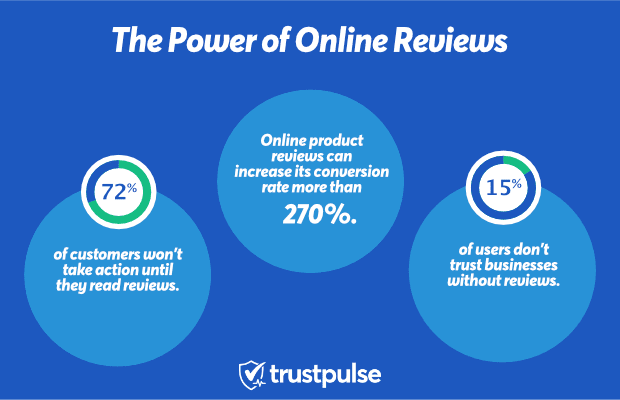
- 91% of millennials trust online reviews as much as friends and family
- A single business review can lift its conversions by 10%
- 72% of customers won’t take action until they read reviews
- Online product reviews about a product can increase its conversion rate by more than 270%
- 49% of consumers need at least a four-star rating before they choose to use a business
- 15% of users don’t trust businesses without reviews
Clearly, you need to pay attention to what people are saying about your business online. Handling reviews, especially the negative ones, are a considerable part of your brand management efforts.
And since Google accounts for 57.5% of all reviews worldwide, that platform is the perfect place to manage your online review strategy.
Now, let’s dive into what you can and can’t do as a business owner when it comes to Google reviews.
Google Review Policy: What You CAN’T Do
One of the core values of Google is to help searchers find what they’re looking for. So when a customer searches for a business, Google wants to make sure that they send them accurate, genuine, and fitting results.
This is just as true for Google search as it is for Google My Business reviews.
So as we look at the following 5 things you can’t do with Google reviews, you shouldn’t think of them as restrictions.
Instead, you should think of Google’s review policies as a way to genuinely help searchers and increase their user experience (UX).
Understanding this core goal of Google (providing accurate and unbiased information to their users) won’t just help you navigate the Google My Busines platform. It will also help your profile and content creation strategy in a way that gets you higher rankings.
With that small disclaimer, let’s look at 5 Google review policies you need to know.
1. Don’t Review Your Own Company
Believe it or not, some business owners think that it’s a good idea to leave a review for their own company.
And we get it.
When you’re starting out and struggling to get more reviews on Google, it can be tempting to kick things off with your own review. What some business owners don’t realize, though, is how inappropriate this tactic is.
Google classifies this kind of behavior as a conflict of interest.

Since you’re the business owner, Google assumes that your review is naturally biased. Anything you do to prioritize your business over Google’s user experience risks getting penalized.
So do yourself a favor and leave your company’s reviews in the hands of your happy customers.
Later, we’ll give you 4 tips you can use to get more Google reviews the right way.
2. Don’t Create Fake Reviews
If you can’t leave a review for your own site, couldn’t you just create multiple accounts and leave reviews for your company that way?
The short answer is: Yes, you can.
The long answer, though, is: Yes, you can, but don’t ever do it.
This is so important that Google addresses it 2 times in their review policies.
First under Spam and fake content:

And second under Impersonation:

Besides being dishonest, relying on fake social proof is one of the worst strategies you could choose to improve your business.
Because not only are you risking heavy penalization from Google that could get you removed from their platform, you also risk losing your clients’ trust.
And once you’ve lost that, it’s an uphill battle gaining it back.
Most online consumers have gotten good at identifying which reviews are real and which reviews are fake. When they see a questionable review on your Google My Business account, they’ll be more likely to look at your competitors who have authentic reviews.
3. Don’t Leave Negative Reviews for Competitors
Another strategy that tempts new business owners is to write a bad review for their competition.
They do this in one of two ways:
- Under their personal account
- Under a fake account
Both approaches can be harmful to your business.

In the same way that Google would penalize you for writing a review for your own business because you’re considered a biased source, you shouldn’t leave reviews on a competitor’s website.
It’s regarded as a conflict of interest.
If you write a negative review using your personal account, you come off as petty. And if you write a review using a fake account, you’ll lose all of your customers’ trust when they learn what you’re doing.
Which they will. Fake reviews always have away coming out.
Focus on improving your own business instead of cutting down your competition. You can easily make improvements to your Google My Business account by adding photos, posting more detailed information about what you do, or responding to reviews.
4. Don’t Spam Other Accounts With Links, Contact Info, or Promotional Deals
Another poor marketing tactic that Google doesn’t allow on their site is leaving spam comments on other company accounts.
That includes things like leaving a comment that has links leading back to your site, your promotional deals, or your contact information.
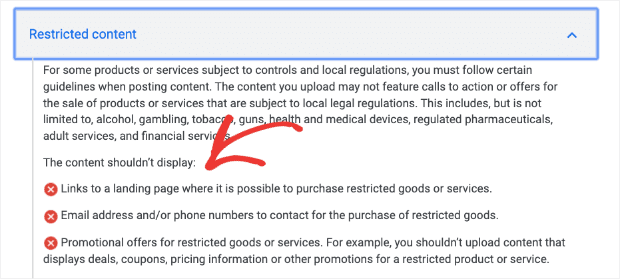
And you may think, “But what if I’m giving a genuine review or response? Can’t I include a link pointing back to my own business so people can contact me if they have further questions?”
The answer is simple: no.
While that strategy may work well on other social media platforms such as Quora or Reddit, it has no place on Google My Business.
Reviews posted to other accounts with links, contact information, or promotional deals are explicitly prohibited by Google.
Besides, spamming websites to attract customers is never a good marketing tactic. After all, when people read comments or responses that are too self-promotional, they’ll assume that you only send this type of communication.
Consequently, they’ll be less likely to hand over their contact information when they reach your site.
5. Don’t Post Illegal Activity Including Threats, Intimidation, or Discrimination
Obviously, Google doesn’t allow any kind of illegal activity on its platform. That includes things like threats, intimidation, or any sort of discrimination.
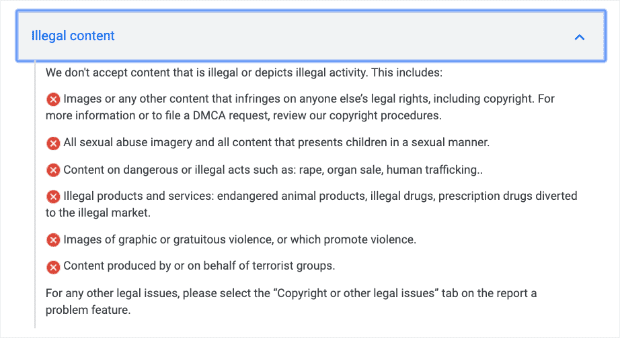
And just like all of the other Google “No-No’s,” Publicly displaying illegal activity or aggressive comments won’t do anything to help your business anyhow.
At the end of the day, it’s important to remember that Google’s restrictions aren’t there to limit you. They’re there to help Google’s users.
But they also don’t do anything to hinder good marketing tactics.
The only thing they prevent are scammy blackhat marketing tricks. And those never work in the long run.
So now that we’ve covered all of the things that you can’t do with Google reviews, let’s look at what you can do to improve your business.
What You CAN Do With Google Reviews
If you really want to grow your business, there are a few ways that you can interact with Google reviews to do so.
Here are 4 actionable techniques you can use to help your business through Google reviews. And the best part is that all 4 of these tips adhere to Google’s review guidelines.
Let’s get started.
1. Display New Reviews on Your Website
Some marketers think that Google reviews can only be seen on Google My Business’s platform. That’s a mistake.
Because you can create custom triggers to allow new Google reviews to be featured on your site.
Once you connect your TrustPulse account with Zapier, you can make a custom notification. Then, anytime someone leaves you a new review, you can show a recent activity popup on your browser:

TrustPulse can create these recent activity popups because we integrate with Zapier. That also means you can set up 1,000’s of custom triggers for any activity involving your brand online.
And doing so is easy!
Simply log into your TrustPulse dashboard and click Create a New Campaign in the top right-hand corner:

After you name your campaign and assign it a site, choose Recent Activity for your campaign type:
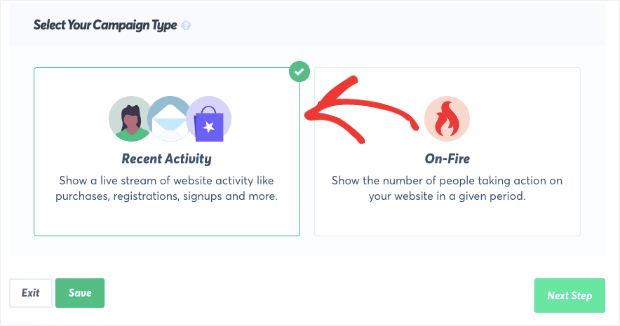
Now you’ll need to design your recent activity popup:

Our out-of-the-box design works for most customers, but you can change any element you like, including:
- Language
- How to refer to visitors
- Message text
- Message link
- Images
- Position of the notification
And more.
What’s important here is to change the Message Text and Message Link. Your Message Text should mention that someone just left you a Google review, and your Message Link should go to your Google My Business account:

Once you’ve found the design that works best for you, you’ll head to the next step. Choose to capture the activity with Zapier:
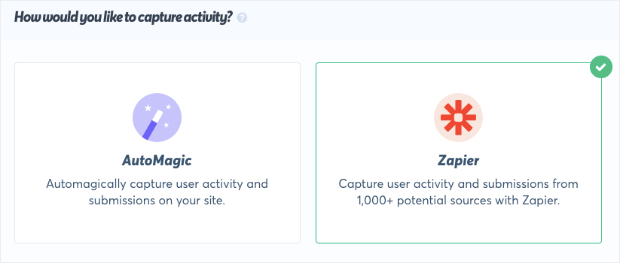
Then connect to Zapier:
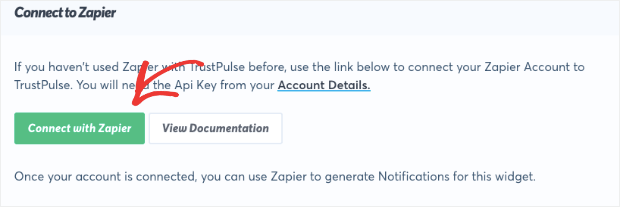
You’ll be redirected to your Zapier dashboard. Click the “+” icon in the top left-hand side of your dashboard to create a new Zap:
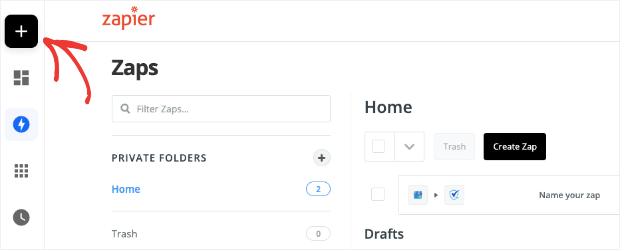
In the When this happens… search field, type in “Google My Business:”
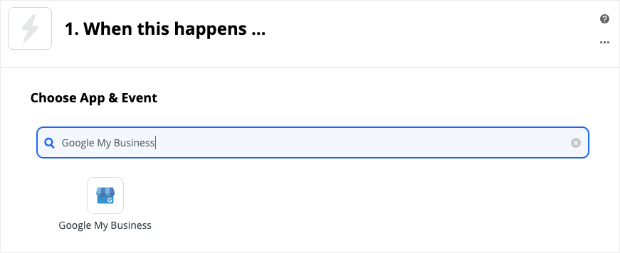
Then select the Google My Business app. Continue the directions as indicated in the Zapier dashboard, including:
- Choose account (selecting your GMB account)
- Customize review
- Find data (optional)
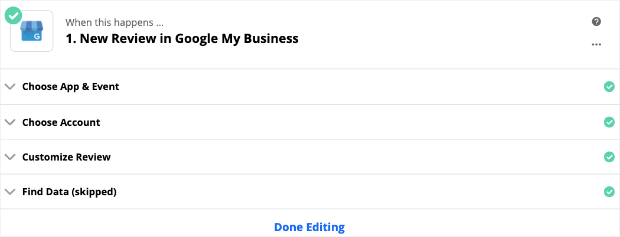
When you’re done editing, you can now hook up your Zapier to your TrustPulse account. You do that in the Do This… section of your campaign creation:
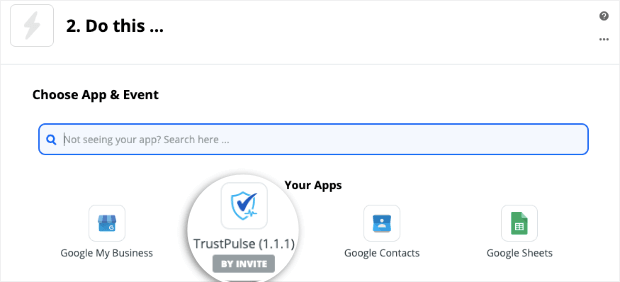
Then, you can customize your notifications and run a test to make sure everything works the way you want. Finally, flip the toggle to activate Zapier at the bottom of your campaign set up:
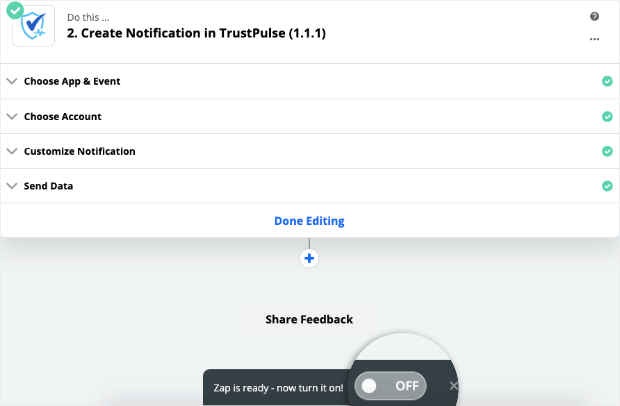
And you’re all set. You’ve now built a recent activity popup that will show your site’s visitors whenever someone leaves you a Google My Business review.
Displaying Google reviews with recent activity popups on your site accomplishes 2 things:
- Shows your site’s visitors that people are talking about your brand
- Allows you to link to the new review so people can read more about how awesome you are
Not only is featuring Google My Business reviews on your personal site a great way of using social proof, but it totally adheres to Google’s review policy.
2. Ask Your Customers to Leave a Review

One of the things that you can do as a business owner is to ask your customers to leave a review. Many times customers don’t even think about leaving a review for something they love.
All they need is a gentle reminder or request to hop online and leave you a great review.
But to stay in line with Google’s review policy, we need to make a crucial distinction:
You can ask customers to leave a review, but you can’t incentivize them to do so.
In other words, you can’t exchange of goods or services to encourage people to leave you a positive review. And you can’t discourage or selectively solicit positive reviews from customers for your business or your competition.
What you can do, though, is provide your customers with stellar customer support, an excellent product or service, and gently send them a follow-up email asking to leave you a Google review.
Crafting an email that asks for a review should be part of any standard email marketing strategy.
So don’t be shy about it!
If you simply request reviews from your clients, you’ll be surprised how many will be happy to help you out.
3. Respond to Positive and Negative Reviews
Once those reviews start coming in, you should set aside some time to respond to them. Responding to reviews makes your company feel more personal, not just to the reviewer, but to anyone reading the comment.
But don’t ignore the negative reviews or selectively respond to the positive ones. In fact, do the opposite.
Spend some extra time writing a response to negative reviews. Instead of taking it as a personal attack, look at it as an opportunity to show potential customers your kind and gracious personality.
Here’s an example of someone who responded to a negative experience the wrong way. The reviewer, Shannon, didn’t enjoy the food served at the owner’s restaurant:

When readers come across this on Google reviews, they’ll likely be turned off to this business.
What the owner should have done is respond to their negative review like this:
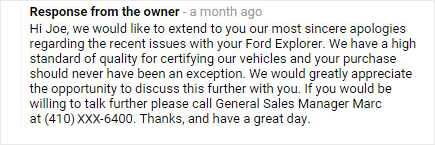
In this example, the business owner is clearly passionate about serving their customers.
Even though they got a negative review, they were able to use it as an opportunity to build relationships with other potential customers.
And, in some cases, the person who left a negative review will be more than happy to change it to a positive one.
Again, all you have to do is ask.
If you adequately resolved an issue with an unhappy customer and improved their customer experience, most will be happy to rewrite the review and put your business in a positive light.
Remember, negative reviews can be one of your best assets and actually make your company seem more credible. So never ignore or prohibit negative reviews. Face them head-on like the excellent opportunity that they are.
4. Leave Reviews for Other Sites Outside of Your Niche
Just because you’re using Google My Business for your own company doesn’t mean that you can’t use it for yourself as well.
In fact, doing so will likely boost your presence on the platform.
Make sure that you’re staying out of your niche, and only leave reviews on businesses that you really like.
Then when other readers see your comments, they’re more likely to click on your profile and see that you have either a local or online business that they can check out, too.
The goal is to be authentically likable.
And leaving positive reviews for other people in different industries is an excellent way of getting some positive exposure for your brand’s image.
And that’s it.
You now have a better understanding of Google review policy along with 4 actionable tips that you can take to get more reviews on Google.
Want even more awesome ideas on how to get Google reviews?
Check out our article on 10 ways to get more reviews for your Google My Business listing.
But What Happens Next?
A lot of times, when it comes to marketing strategies, new marketers will lose the forest for the trees.
In other words, they forget the ultimate goal: creating new customers.
When people see your company profile on Google My Business, the way you handle your account will inspire them to go to your website.
But what then?
It’s essential to have a strategy to build trust with your new visitors. Otherwise, all your hard work and comment moderation will be in vain.
Fortunately, building trust with your customers is easy. A large part of the work can be done by adding recognizable trust badges to your site.
In the past, we’ve written about how to use trust badges to make your website more credible. These include things like adding testimonials, money-back guarantee seals, and other useful types of social proof.
If you haven’t’ read that article yet, you should definitely check it out.
The one trust badge we recommend the most is recent activity popups, which we already covered in this post:
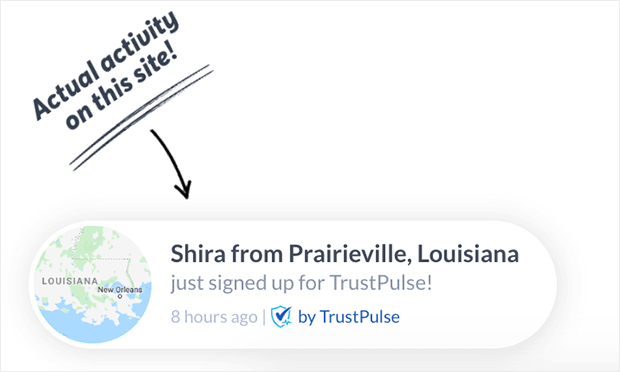
Those are our wheelhouse. 😉
TrustPulse provides recent activity popups for websites to display their credibility to new visitors. But these notifications aren’t limited to new Google reviews.
Any time someone takes any positive action on your site, the popup will appear for other customers.
This accomplishes 2 things:
- As we already mentioned, it inspires trust in your site’s new visitors
- It builds a fear of missing out in those visitors and encourages them to take a similar action
In fact, we’ve seen sales increase up to 15% from these tiny popups. That means one little change to your site could easily create thousands of dollars of new revenue.
Plus, with TrustPulse, your customers will know that these notifications are genuine. Some software allows, and even encourages, you to use fake social proof. They display popups when no action was actually taken on your site.
Just like leaving fake reviews on Google, this is one of the worst strategies you can have. Once your customers learn that your software can generate fake social proof, they’ll assume every recent activity notification is a fake.
Even if it isn’t.
Then you’ll spend more time trying to repair your online reputation instead of focusing on what counts: serving your customers and making a profitable business.
With TrustPulse, you get the best of both: authentic social proof from a company your clients can trust.
We hope that you enjoyed reading this article. Do you have any tips, tricks, or fun stories about Google reviews?
If so, reach out to us on Facebook, Twitter, or in the comment section below. We’d love to hear from you!
And if you’d like to boost your company’s conversion up by 15% (and who wouldn’t?), then maybe it’s time to make a small change to your site.
Join the TrustPulse community and get started today!
